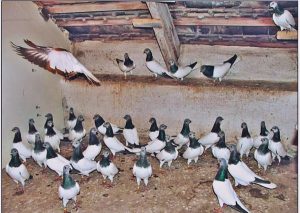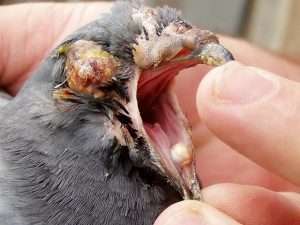Prevention of epidemics is largely about methods and techniques to protect our pigeons from infectious pathogens. Epidemic control is primarily a matter of determination and attention, and has only a negligible financial cost. It takes will, not a lot of money.
However, if we do not take epidemic control seriously and allow pathogens free access to the loft, we will immediately feel the financial consequences of our mistake. You don’t even have to open the gates wide: If you leave even a little gap on the shield of epidemic control, it means many lost pigeons and very high veterinary and medical bills.
We are well aware that today the health care of pigeon flocks is unthinkable without the use of medicines. Yet we must constantly strive to keep the use of medicines as low as possible. This is not only in our own interest, but also in the interest of the pigeons and the environment.
Not having to spend a lot on medicines means that our flock is healthy, but that doesn’t happen by itself. We can achieve this primarily through well-planned and continuously applied epidemic control.
In this article we describe what simple and therefore cheap, but effective epidemic control looks like.
By ‘epidemics’ we mean spread of contagious diseases, while by prevention we mean the methods with the help of which we try to protect our flock from the pathogens that cause contagious diseases.
It is not an easy task. When moving from one place to another, pigeons, like all other animals, take all the bacteria, viruses, fungi and parasites in and on their bodies with them – the whole menagerie, as it were. Moreover pigeon breeding, in particular the use of racing pigeons, quite literally knows no bounds. At exhibitions, races and fairs, our pigeons not only travel a lot within their country, but often cross national borders to return to their lofts. During transportation and flying, in the course of exhibitions and fairs, coming into contact with countless other pigeons (and other birds), or at least being in the same space as them, they can catch or transmit many types of pathogens they were previously unaware of.
Such is the nature of this sport. But, precisely because of this, we must do everything we can to protect our pigeons from repeated attacks from hordes of pathogens. And this is not possible without strict measures to prevent epidemics.
Prevention of epidemics is not only important outside the yard, i.e. during transportation on domestic and international trips. We must also maintain continuous protection within the yard, as even when at home our pigeons are exposed to the danger of infection day and night – a danger which is sometimes presented by the fancier himself or herself. Prevention of epidemics must be in place between lofts; indeed, even within the loft we must do all we can to see that pathogens are transferred from diseased to healthy birds as little as possible.
In summary, we can consider prevention of epidemics as the breaking of the chain of infection. We can separate it into the following four components:
.
Prevention of epidemics:
1. outside the yard
2. between the yard and the outside world
3. between lofts
4. within the loft
.
Let us examine these in more detail. We cannot claim that each of the following recommendations can be observed for all flocks, as each yard has its own different characteristics. Certain methods can only be implemented in a particular place with considerable difficulty, and so will not be applicable everywhere. But the more methods of prevention of epidemics you can successfully implement, the more healthy and beautiful a flock you will have in the long run. And the beneficial effect on your wallet you will feel even more quickly.
Some of the following tips will seem banal to some, but even the most experienced fanciers sometimes forget about the most basic measures to be taken against epidemics. It does no harm to look at these in turn.
.
1. Prevention of epidemics outside the yard
As we discussed above, each flock, and within that each individual pigeon has its own “menagerie”, that is to say the entirety of the bacteria, viruses, fungi, and internal and external parasites which are present in or on its body. These are for the most part innocent creatures that do not cause disease, but there can be pathogens among them, too. One of the fundamental rules for the prevention of epidemics is that birds that carry and spread pathogens should not be placed among healthy birds. So we must not take a visibly ill pigeon to an exhibition, race, fair, etc., because in doing so we not only compromise our reputation, but also break the law, not to mention infecting others’ flocks.
Most fanciers follow this rule. The problem starts when a seemingly healthy, but in fact infected pigeon is placed among the healthy ones. The infected pigeon sheds pathogens and spreads disease among the others. The only way to avoid this is to carry out continuous epidemic prevention in your flock. This includes strict quarantine and regular vaccination of birds.
The situation is more complicated than it first appears. The spread of diseases is greatly facilitated by the fact that a caged pigeons transported over a long distance become stressed. During stress, hormonal processes occur that suppress the immune system. The weakening of the body’s defence mechanism leads to the proliferation of pathogens (viruses, bacteria, fungi, parasites) that were previously suppressed and hiding in various organs. Pathogens multiply in the body and are then released in large quantities. The previously healthy pigeon thus becomes a dangerous, continuous and massive source of infection.
Transportation and its related tasks (basketing etc.) put considerable stress on the pigeons in any case, and so every effort must be taken to see that the vehicle and the baskets used for transportation are not overcrowded. Overcrowding not only worsens stress, but also helps the transfer of pathogens from one bird to another. Ideally, pigeons from different breeders should be transported in separated sections of the vehicle. This is impossible to implement in the majority of cases, of course. This is why it is important for pigeon fanciers to bring perfectly healthy pigeons to races and shows.
(To be continued)







